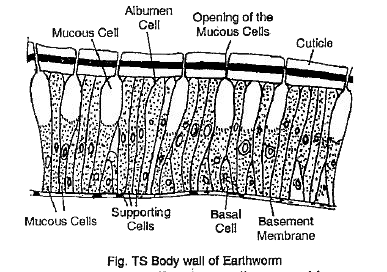Describe body wall of earthworm.
Body wall. It consists of cuticle, epidermis, muscular layer, parietal peritoneum.
I. Cuticle. It is a thin delicate non-cellular, chitinous irridescent membrane which covers the entire body of the earthworm. It bears minute pores for the opening of nephridia. It is secreted by the underlying epidermis.
Chemical composition. The cuticle is made up of polysaccharides, collagen and a little amount of gelatin.
2. Epidermis. It lies beneath the cuticle and consists of a single layer ofrells. The cells are of five kinds.
(i) Supporting cells. The cells are tall and narrow and having a centrally placed nucleus. The supporting cells constitute the major portion of the epidermis and provide support to the other cells.
(ii) Glandular cells. These are of two kiilds mucous cells and albumen cells.

(a) Mucous cells. These cells are ovoid. The distal part of each cell is filled with mucus whil the proximal or basal part contains mainly cytoplasm and nucleus. These numerous mucous cells secrete mucus which is passed outside to keep the body wall moist.
(b) Albumen cells, These cells are columnar. The secretory granules in these cells are uniformly distributed. They are restricted to a few anterior segments and in the clitellar segments.
The albumen cells secrete albumen which helps in the formation of ootheca.
(iii) Basal cells. They are situated in between the basal ends of the supporting and glandular cells. They are either rounded or conical and contains a distinct rounded nucleus. They get transformed into the supporting and glandular cells.
(iv) Receptor cells. They are restricted to certain regions and occur in groups. The receptor cells are elongated narrow with hair like processes. Their inner ends are innervated by nerve fibres. They are sensory cells and respond to external stimuli.
( v) Seta-forming cells. These epidermal cells are invaginated to form setal sacs. The latter secrete the setae which are the locomotory organs. Setae are found embedded in the body wall.
3. Muscular layer. It lies inner to the epidermis. It consists of an outer layer of circular muscles and an inner layer of longitudinal muscles. A set of circular muscles also lies outer to parietal peritoneum. The longitudinal muscles layer lies in long parallel bundles and this layer is generally more than twice as thick as the circular muscles layer. In the region of setae, the parallel bundles of longitudinal muscles are separated by the muscle fibres of unstriped type. By the contraction of circular muscles the length of the body is increased and the thickness is decreased, while due to the contraction of longitudinal muscles the length of the body is decreased and the diameter is increased. All muscles are unstriped.

Similar Questions
Correct the wrong statements among the following:
(a) In earthworm, a single male genital pore is present.
(b) Setae help in locomotion of earthworm.
(c) Muscular layer in the body wall of earthworm is made up of only circular muscles.
(d) Typhlosole is the part of intestine of earthworm.View SolutionMark the incorrect statement about the body wall of earthworm
View Solution
Knowledge Check
- Question 1 - Select One
Which of the following layers you will find in the body wall of earthworm (from outside to inside) ?
ANon-cellular cuticle, epidermis, circular muscles, longitudinal muscles, coelomic epitheliumBCuticle, epidermis, longitudinal muscles,circular muscles, coelomic epitheliumCNon-cellular cuticle, epidermis, coelomic epithelium, circular muscles, longitudinal musclesDCuticle,epdermis,peritoneal muscles - Question 2 - Select One
Which of the following layers you will find in the body wall of earthworm (from outside to inside) ?
ANoncellular cuticle, epidermis, circular muscles, longitudinal muscle, coelomic epitheliumBCuticle, epidermis, longitudinal muscles, circular muscles, coelomic epitheliumCCuticle, epidermis, coelomic epithelium, circular muscle, longitudinal muscleDCuticle, epidermis, peritoneum muscles - Question 3 - Select One
Which of the following layers you will find in the body wall of earthworm (from outside to inside) ?
ANon-cellular cuticle, epidermis, circular muscles, longitudinal muscles, coelomic epitheliumBCuticle, epidermis, longitudinal muscles,circular muscles, coelomic epitheliumCNon-cellular cuticle, epidermis, coelomic epithelium, circular muscles, longitudinal musclesDCuticle,epdermis,peritoneal muscles
Name the various layers of body wall in earthworm.
View SolutionName the various layers of body wall in earthworm.
View SolutionMention the function of the following
(a) Ureters in frog
(b) Malpighian tubules
(c) Body wall in earthwormView SolutionThe body wall of earthworm is covered by which of the following layers
(externally - internally ) ?View SolutionThe correct sequence of different layers in the body wall of the earthworm from outer to inner side is
View Solution

